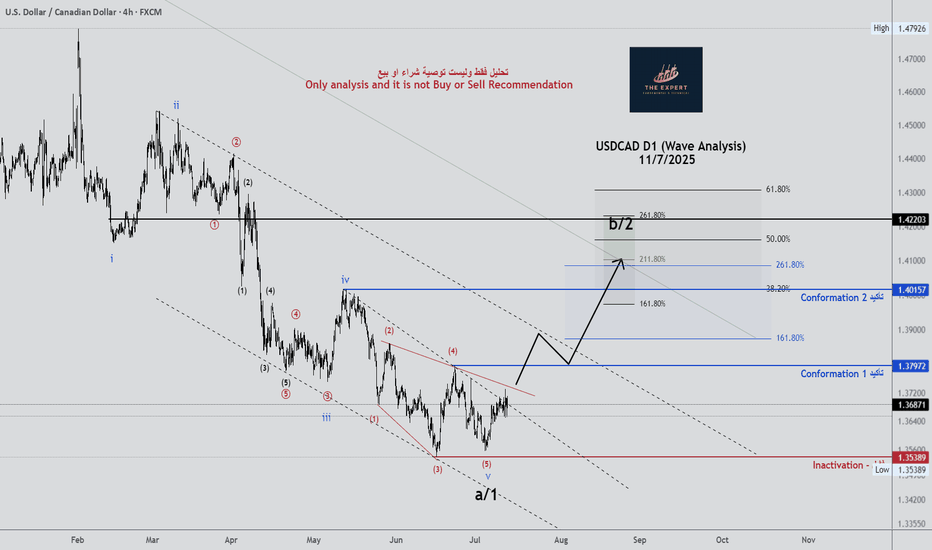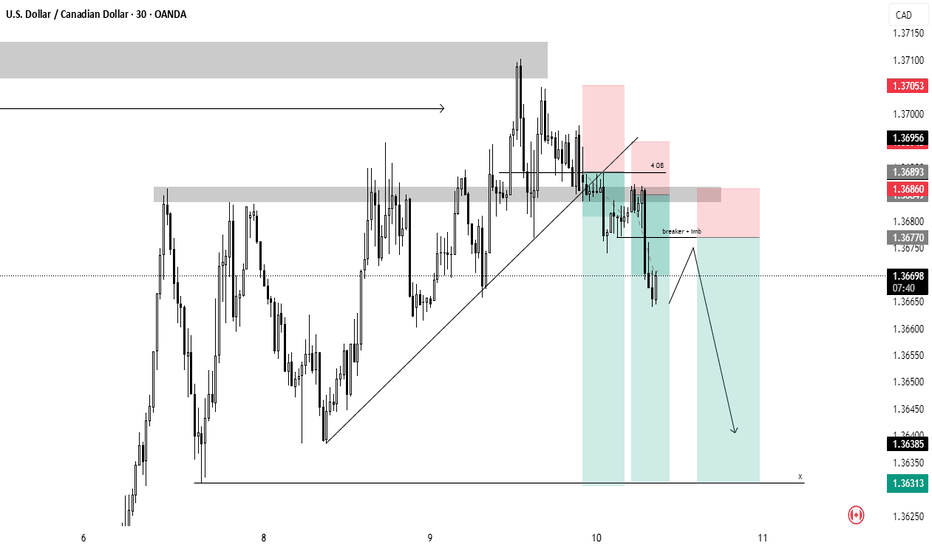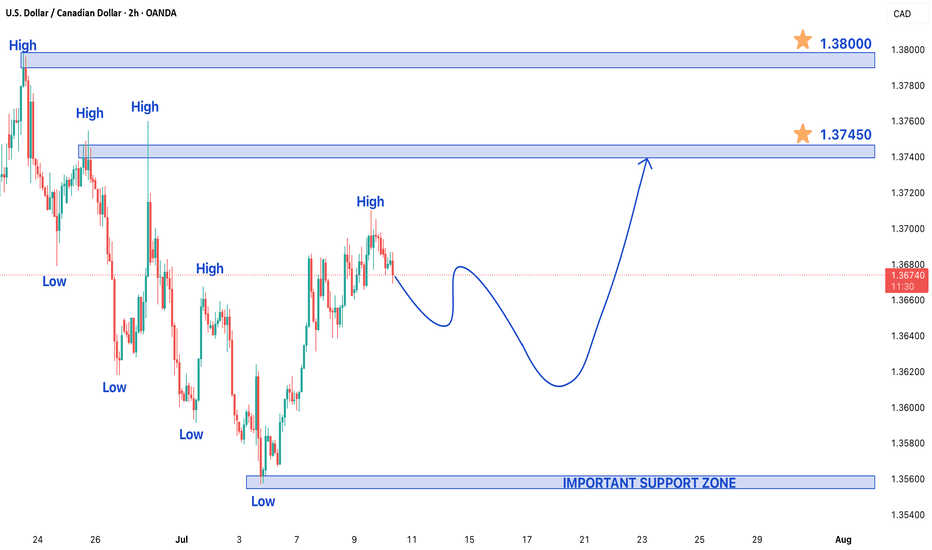CADUSD trade ideas
USD/CAD - Potential TargetsDear Friends in Trading,
How I see it,
PIVOT AREA @ 1.37000 - 1.37208
1) Pair is under fundamental pressure at this time.
2) We need a strong breach above PIVOT area to signal any
chance for broader bullish price action.
Keynote:
1.35775 = Key Demand
I sincerely hope my point of view offers a valued insight.
Thank you for taking the time to study my analysis.
USDCAD MARKET OUTLOOK📊 USDCAD Institutional Market Outlook
🔷 Monthly & Weekly Structure – Bearish Bias
A Monthly Fair Value Gap (FVG) was formed after a breakaway gap, closing all prior bullish FVGs. This signals strong bearish intent from institutions, with a likely draw toward the next key liquidity level at 1.34210.
Similarly, a Weekly FVG, also formed from a breakaway imbalance, is currently acting as an unmitigated supply zone. Historically, FVGs formed from breakaway moves are not revisited until the market completes its delivery to a main liquidity pool — in this case, the 1.34210 level.
Price is now consolidating below this weekly FVG, reinforcing a continuation bias rather than reversal.
🔹 Daily Structure – Short-Term Countertrend Rally
A bullish Daily FVG has recently formed, suggesting a possible short-term countertrend rally.
However, due to the breakaway nature of the weekly FVG, price is unlikely to reach back up to 1.3760 before continuing its bearish path.
A probable scenario: price may react from daily demand zones, push into a short-term premium area, then resume its decline toward 1.34210.
🌐 Fundamental Confluence
🟥 CAD Weakness:
U.S. tariff policy is placing heavy pressure on the Canadian economy, especially in autos, steel, and oil sectors.
Recent SECO reports and tariff-related projections expect a long-term GDP drag of ~2.1%.
Although oil prices have slightly rebounded, it's not enough to counterbalance the trade and policy headwinds.
🟩 USD Strength:
The U.S. dollar remains supported by global safe haven flows and a resilient macro backdrop.
No significant shift in Fed policy tone has emerged, and the USD continues to benefit from relative strength across multiple pairs.
| Timeframe | Bias | Reason |
| ------------ | ------------------------ | ------------------------------------------------------------------------- |
| Monthly | Bearish | Breakaway FVG + closed bullish zones → draw toward 1.34210 |
| Weekly | Bearish | Consolidation below breakaway supply zone |
| Daily | Short-term bullish | Countertrend move expected into local premium, likely to fail near 1.3760 |
| Fundamentals | Bearish CAD, Bullish USD | Tariff risks + economic divergence
USDCADThe US tariffs have had a mixed but generally weakening effect on the Canadian dollar (CAD) , influencing the USD/CAD exchange rate
Current Exchange Rate Context
As of July 11, 2025, the USD/CAD rate is around 1.37-1.3698 , with the US dollar strengthening and the Canadian dollar weakening about 0.7% over the past month.
Impact of US Tariffs on CAD Strength
Trade Exposure:
Canada is highly integrated with the US economy, with over 70% of Canadian exports going to the US. Tariffs on Canadian goods or retaliatory tariffs can reduce trade volumes and economic growth in Canada, weakening the CAD.
Market Sentiment and Risk:
Tariff uncertainties create volatility and risk aversion, often benefiting the safe-haven USD at the expense of commodity-linked currencies like CAD.
Commodity Prices:
Tariffs can disrupt global supply chains and commodity demand. Since Canada is a major oil exporter, any negative impact on oil prices due to trade tensions tends to weaken the CAD.
Interest Rate and Economic Outlook:
Trade tensions may lead to cautious monetary policy by the Bank of Canada, limiting rate hikes or prompting cuts, which can reduce the interest rate differential versus the US and weigh on CAD
2. Interest Rates
Bank of Canada (BoC) Overnight Target Rate: 2.75% (held steady as of July 9, 2025).
Canadian government 10 year bond yield is 3.419%
US Federal Reserve Rate: Around 4.5% (market consensus for mid-2025).
United states government 10 year bond yield is 4.38%-4.4%
The interest rate differential between the US and Canada remains significant, favoring USD, which supports USD strength against CAD.
US 10-Year Treasury Yield: Generally higher than Canadian yields, around 4.38%–4.4% (market consensus), maintaining a yield advantage for USD assets.
4. Impact on USD/CAD
The higher US interest rates and bond yields relative to Canada make USD-denominated assets more attractive, contributing to the USD’s strength against CAD.
Conclusion
The US tariff policies in 2025 have contributed to a weaker Canadian dollar by increasing economic uncertainty, disrupting trade, and pressuring commodity prices. This has supported the US dollar’s recent strength against CAD, pushing the USD/CAD rate toward the higher .
#usdcad #cad #usd
US Dollar Strengthens Following Trump’s Tariff DecisionUS Dollar Strengthens Following Trump’s Tariff Decision
US President Donald Trump has announced his decision to impose new tariffs:
→ For Canada, tariffs are set at 35%. They are scheduled to take effect on 1 August, although negotiations may take place before this date, potentially influencing Trump’s final stance.
→ For many other countries, tariffs may be set at 15% or 20%;
→ For the European Union, the exact tariff levels have not yet been disclosed.
Overall, Trump’s latest comments have added to the uncertainty surrounding the specific tariffs to be applied to each country. The financial markets reacted as follows:
→ The US dollar strengthened against other currencies (including the Canadian dollar);
→ Equity markets saw a modest decline.
Technical Analysis of the USD/CAD Chart
As soon as the announcement of a 35% tariff on Canadian imports to the US was made public, the USD/CAD rate spiked sharply (as indicated by the arrow), reaching levels last seen at the end of June. In the hours that followed, the pair stabilised.
Taking a broader view, the chart appears to show a triangular formation, which consists of:
→ A descending resistance line (R);
→ A key support level (S) around 1.3570.
From this perspective, it is worth noting that the bulls’ attempt to break above the resistance line amid the 35% tariff news did not succeed, indicating strong selling pressure.
At the same time, the price action of USD/CAD in early July allows us to identify a local support level (marked by the blue line). This suggests that, for now, the pair is consolidating within a formation bounded by the blue support line and resistance line R.
However, how long this consolidation will last, and which direction the breakout will take, will most likely depend on the next round of news regarding US–Canada trade negotiations.
This article represents the opinion of the Companies operating under the FXOpen brand only. It is not to be construed as an offer, solicitation, or recommendation with respect to products and services provided by the Companies operating under the FXOpen brand, nor is it to be considered financial advice.
USDCAD I Weekly CLS I Model 1 I KL - OB I Target CLS LowYo Market Warriors ⚔️
BIG SHORT — if you’ve been riding with me, you already know:
🎯My system is 100% mechanical. No emotions. No trend lines. No subjective guessing. Just precision, structure, and sniper entries.
🧠 What’s CLS?
It’s the real smart money. The invisible hand behind $7T/day — banks, algos, central players.
📍Model 1:
HTF bias based on the daily and weekly candles closes,
Wait for CLS candle to be created and manipulated. Switch to correct LTF and spot CIOD. Enter and target 50% of the CLS candle.
For high probability include Dealing Ranges, Weekly Profiles and CLS Timing.
Trading is like a sport. If you consistently practice you can learn it.
“Adapt what is useful. Reject whats useless and add whats is specifically yours.”
David Perk aka Dave FX Hunter
💬 Don't hesitate to ask any questions or share your opinions
USDCAD's Opportunity Bell Is Ringing — Don’t Miss Out!Hey there, my valued friends!
I’ve prepared a fresh USDCAD analysis just for you.
📌 If the 1.37245 level breaks, the next target will be 1.38000.
Every single like you send my way is the biggest motivation behind sharing these analyses.
🙌 Huge thanks to each and every one of you who supports me!
Would you like to add a visual or a catchy headline to boost engagement even more? I can help with that too.
USDCAD upside target 1.3960On the 4-hour chart, USDCAD stabilized and moved upward, with bulls taking the upper hand. The current market has formed a potential double bottom pattern. In the short term, attention can be paid to the resistance near 1.380. A breakthrough will hopefully continue to move higher, with the upward target around 1.3960. When the price reaches 1.3960, attention can be paid to the bearish bat pattern.
USDCAD LONG DAILY FORECAST Q3 D11 W28 Y25USDCAD LONG DAILY FORECAST Q3 D11 W28 Y25
It’s Fun Coupon Friday! 💸🔥
Professional Risk Managers👋
Welcome back to another FRGNT chart update📈
Diving into some Forex setups using predominantly higher time frame order blocks alongside confirmation breaks of structure.
Let’s see what price action is telling us today! 👀
💡Here are some trade confluences📝
✅Daily Order block identified
✅4H Order Block identified
✅1H Order Block identified
🔑 Remember, to participate in trading comes always with a degree of risk, therefore as professional risk managers it remains vital that we stick to our risk management plan as well as our trading strategies.
📈The rest, we leave to the balance of probabilities.
💡Fail to plan. Plan to fail.
🏆It has always been that simple.
❤️Good luck with your trading journey, I shall see you at the very top.
🎯Trade consistent, FRGNT X
4 HOUR CONFIRMATION- USDCAD ENTRY UPDATEPrice tapped in our Weekly Demand ideal 👌 for long buys.
Previously i anticipated a trend shift H4 as guide , cmp price just break our int previous high meaning change a in trend as we anticipated
Now waiting for price to drop to our int demand then we rise or the breaker block can hold - major reactions
Bearish drop off pullback resistance?USD/CAD has rejected off the resistance level which is a pullback resistance and could drop from this level to our take profit.
Entry: 1.3695
Why we like it:
There is a pullback resistance.
Stop loss: 1.3740
Why we like it:
There is a pullback resistance that lines up with the 78.6% Fibonacci retracement.
Take profit: 1.3618
Why we like it:
There is a pullback support that lines up with the 61.8% Fibonacci retracement.
Enjoying your TradingView experience? Review us!
Please be advised that the information presented on TradingView is provided to Vantage (‘Vantage Global Limited’, ‘we’) by a third-party provider (‘Everest Fortune Group’). Please be reminded that you are solely responsible for the trading decisions on your account. There is a very high degree of risk involved in trading. Any information and/or content is intended entirely for research, educational and informational purposes only and does not constitute investment or consultation advice or investment strategy. The information is not tailored to the investment needs of any specific person and therefore does not involve a consideration of any of the investment objectives, financial situation or needs of any viewer that may receive it. Kindly also note that past performance is not a reliable indicator of future results. Actual results may differ materially from those anticipated in forward-looking or past performance statements. We assume no liability as to the accuracy or completeness of any of the information and/or content provided herein and the Company cannot be held responsible for any omission, mistake nor for any loss or damage including without limitation to any loss of profit which may arise from reliance on any information supplied by Everest Fortune Group.
USDCAD I Weekly CLS I Model 1 I Targe 50% CLSYo Market Warriors ⚔️
Fresh outlook drop — if you’ve been riding with me, you already know:
🎯My system is 100% mechanical. No emotions. No trend lines. No subjective guessing. Just precision, structure, and sniper entries.
🧠 What’s CLS?
It’s the real smart money. The invisible hand behind $7T/day — banks, algos, central players.
📍Model 1:
HTF bias based on the daily and weekly candles closes,
Wait for CLS candle to be created and manipulated. Switch to correct LTF and spot CIOD. Enter and target 50% of the CLS candle.
For high probability include Dealing Ranges, Weekly Profiles and CLS Timing.
Trading is like a sport. If you consistently practice you can learn it.
“Adapt what is useful. Reject whats useless and add whats is specifically yours.”
David Perk aka Dave FX Hunter
💬 Don't hesitate to ask any questions or share your opinions
USDCAD – July 10 OutlookUSDCAD’s high-risk, high-reward (HRHR) sells from Wednesday are still in play with price currently up 35 pips. Price action remains within the structure as we continue to respect the March trendline, but are now stalling in a tight 4H range.
📍 Key Observations:
1.36647 is acting as strong intraday support
Possible retest of yesterday’s or Wednesday’s high could provide another HRHR sell opportunity
Break below 1.36527 could open the door for a clean 70-pip move toward 1.35827
🔔 Summary: Patience is essential—watching for either another short-term rejection at resistance or a clean structural break to continue the broader bearish bias.
USDCAD Entering Bullish Trend on 2-Hour Chart – Key LevelsUSDCAD Entering Bullish Trend on 2-Hour Chart – Key Levels and Analysis
The USDCAD pair is showing early signs of a potential bullish trend reversal on the 2-hour chart, as price action has formed a Higher High, indicating a shift in market structure. This pattern suggests that buyers are gradually gaining control, which could lead to further upside momentum if the trend continues. However, in the short term, the pair may still experience some bearish pressure before confirming a full bullish breakout.
Current Market Structure and Bullish Indications
- The formation of a Higher High signals that the downtrend may be weakening, and buyers are stepping in at higher levels.
- If the price holds above recent swing lows, it could confirm the beginning of a new uptrend phase.
- However, traders should remain cautious, as a temporary pullback or consolidation is possible before a sustained upward move.
Key Support Level: 1.35500
On the downside, 1.35500 is a critical support zone. This level has previously acted as both resistance and support, making it a strong area for buyers to defend.
- Bullish Scenario: If the price bounces from 1.35500, it could reinforce the bullish outlook and provide a base for further upward movement.
- Bearish Risk: A decisive break below this level could delay the bullish reversal and lead to a deeper retracement toward 1.35000 or lower.
Upside Targets: 1.37450 & 1.38000
If the bullish momentum strengthens, the next key resistance levels to watch are:
1. 1.37450 – A break above this level could accelerate buying interest.
2. 1.38000 – A major psychological and technical resistance zone where profit-taking may occur.
Short-Term Bearish Possibility Before Bullish Continuation
Despite the bullish signals, the pair may still face short-term bearish pressure due to:
- Profit-taking near resistance levels.
- Potential USD weakness or CAD strength in upcoming sessions.
- Market consolidation before the next directional move.
Trading Strategy & Key Takeaways
- Confirmation Needed: Wait for a strong close above recent highs to confirm the bullish trend.
- Support Watch: A hold above 1.35500 keeps the bullish structure intact.
- Targets: If bullish momentum continues, 1.37450 and 1.38000 are the next key objectives.
- Risk Management: A break below 1.35500 could invalidate the bullish setup, leading to a reassessment of the trend.
Conclusion
The USDCAD is showing early signs of a bullish reversal on the 2-hour chart, but traders should remain cautious of short-term bearish retracements. The critical levels to watch are 1.35500 (support) and 1.37450–1.38000 (resistance targets). A confirmed breakout above resistance could signal a stronger bullish trend, while a breakdown below support may extend the correction phase. Proper risk management and confirmation through price action will be essential for successful trading in this scenario.






















